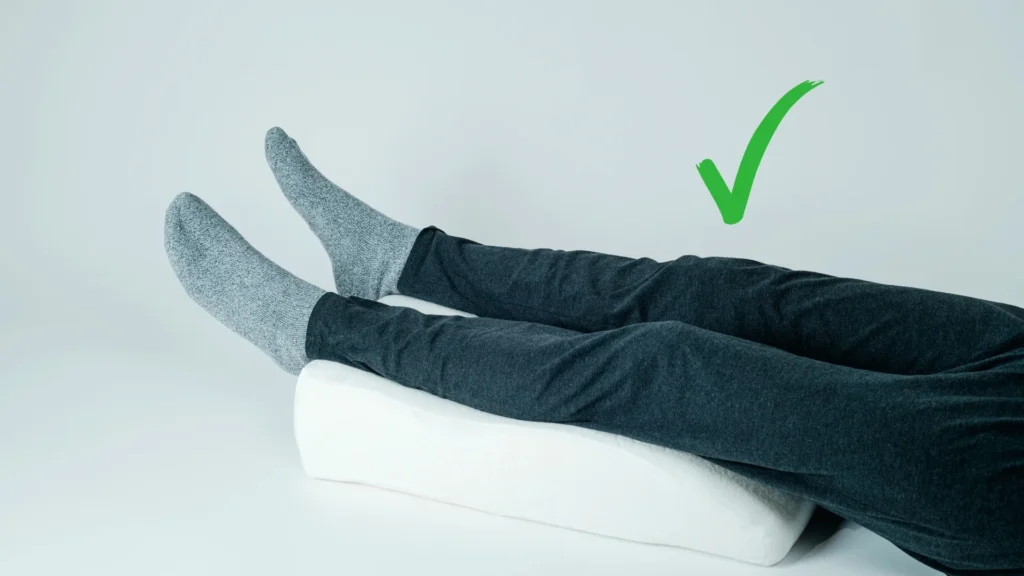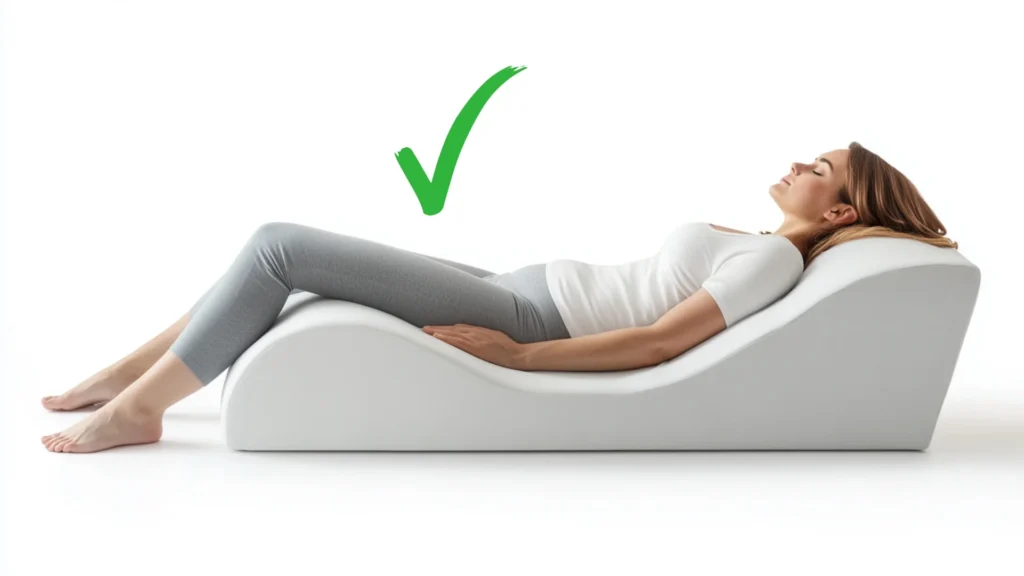Living with peripheral artery disease (PAD) can make getting a good night’s sleep challenging. The discomfort and pain associated with this condition often worsen at night, leaving many tossing and turning. But did you know that finding the best sleeping position for peripheral artery disease can make a significant difference in your comfort and overall health?
In this article, we’ll explore how simple changes to your sleeping position can help improve circulation, reduce pain and enhance your sleep quality. Whether you’re newly diagnosed with PAD or have been managing it for years, these tips could be the key to more restful nights.
We’ll dive into various sleeping positions, discuss their benefits and provide practical advice on how to implement them. By the end of this article, you’ll have a clear understanding of how to optimise your sleep for better management of PAD symptoms. Let’s get started on your journey to more comfortable and restorative sleep!
But first, What is Peripheral Artery Disease?
Peripheral Artery Disease (PAD) is a condition that affects blood flow in the body’s extremities, particularly the legs. It occurs when arteries narrow, reducing blood supply to the limbs. This can lead to various symptoms, including:
- Pain or cramping in the legs during activity
- Numbness or weakness in the legs
- Cold feet or legs
- Slow-healing sores on toes, feet, or legs
PAD can significantly impact sleep quality, making finding the best sleeping position for peripheral artery disease crucial. The discomfort often worsens at night, as lying down can reduce blood flow to the affected areas. This can cause a burning sensation or leg cramps that disrupt sleep.
Understanding PAD is the first step in managing its symptoms, especially during sleep. By recognising how the condition affects circulation, you can make informed decisions about your sleeping position and habits to improve both your comfort and overall health.
Sleep Positions to Avoid

Before we talk about the best sleeping position for peripheral artery disease, let’s first talk about which positions to avoid. Certain sleeping positions can worsen symptoms and hinder blood flow, making your condition more uncomfortable.
Sleeping with Legs Crossed
This position can restrict blood flow in your legs, exacerbating PAD symptoms. It puts unnecessary pressure on your blood vessels and nerves, potentially leading to increased pain and numbness.
Prolonged Periods in One Position
Staying in the same position for too long can reduce circulation. Try to shift your position gently every few hours if possible. This doesn’t mean you need to fully wake up, but small movements can help promote blood flow.
Sleeping Flat on Your Back Without Elevation
While back sleeping can be beneficial, lying completely flat may not provide the best circulation for PAD sufferers. A slight elevation can make a significant difference.
Stomach Sleeping
This position can put strain on your lower back and potentially restrict blood flow to your legs.
By avoiding these positions, you can help ensure better circulation and more comfortable sleep. Remember, the goal is to find a position that promotes blood flow and reduces discomfort throughout the night.
The Best Sleeping Position for Peripheral Artery Disease
Finding the best sleeping position for peripheral artery disease can significantly improve your comfort and sleep quality. Here are some positions that may help:
Elevated Legs Position

Raising your legs above heart level can promote better blood flow. To achieve this:
- Lie on your back
- Place pillows under your legs to elevate them
- Ensure your knees are slightly bent for comfort
This position helps reduce swelling and can ease discomfort in your legs.
Side Sleeping

Side sleeping can be beneficial if done correctly:
- Lie on your side with a pillow between your knees
- Keep your legs slightly bent
- Use a body pillow for additional support
This position can help reduce pressure on your legs and improve circulation.
Back Sleeping with Slight Elevation

A variation of the traditional back-sleeping position:
- Lie on your back
- Use a wedge pillow or adjust your bed to create a slight incline
- Keep your head elevated slightly above your feet
This gentle elevation can help improve overall circulation without putting pressure on specific areas.
Take note that the best sleeping position for peripheral artery disease may vary from person to person. It’s important to experiment with these positions to find what works best for you. If you experience persistent discomfort, consult your healthcare provider for personalised advice.
Additional Considerations
While finding the best sleeping position for peripheral artery disease is crucial, there are other factors to consider for improved sleep:
Compression Stockings: Wearing these during the day and removing them before bed can help manage swelling and improve circulation.
Regular Movement: Even at night, gentle movement is beneficial. If you wake up, try simple ankle rotations or leg stretches.
Bedding: Choose a mattress that provides adequate support. A mattress topper can add extra comfort if needed.
Room Temperature: Keep your bedroom cool to promote better circulation and sleep.
Pain Management: Consult your doctor about pain relief options if discomfort is severely affecting your sleep.
Lifestyle Factors: Maintain a healthy diet, exercise regularly and avoid smoking to support overall circulation.
Sleep Schedule: Stick to a consistent sleep routine to help regulate your body’s internal clock.
Remember, while these tips can help, it’s important to consult your healthcare provider if you’re experiencing persistent sleep issues or worsening PAD symptoms.
Take Charge of Your Sleep Tonight!

Finding the best sleeping position for peripheral artery disease can significantly improve your quality of life. By elevating your legs, trying side sleeping or adjusting your back-sleeping position, you can enhance circulation and reduce discomfort during the night.
Remember, there’s no one-size-fits-all solution. What works best for you may require some experimentation. Pay attention to how your body responds to different positions and make adjustments as needed.
Don’t forget to consider additional factors like compression stockings, regular movement and a comfortable sleep environment. These elements work together with your sleeping position to create the best possible conditions for restful sleep.
Ready to transform your nights? Start implementing these tips tonight. Be patient with yourself as you find what works best for you. If you continue to struggle with sleep or PAD symptoms, don’t hesitate to reach out to your healthcare provider for personalised advice. Sweet dreams and better health await!
Read These Next:
What is the Best Sleeping Position for Baby with Stuffy Nose?
The Best Pillow after Heart Surgery
FAQs about Sleeping with Peripheral Artery Disease
Q: Can sleeping position really affect my PAD symptoms?
A: Yes, finding the best sleeping position for peripheral artery disease can significantly impact your symptoms by improving circulation and reducing discomfort.
Q: How high should I elevate my legs when sleeping?
A: Aim to raise your legs about 6-12 inches above heart level. Use pillows or a wedge pillow for support.
Q: Is it normal to feel pain when changing sleeping positions?
A: Some discomfort when moving is common with PAD. If pain is severe or persistent, consult your doctor.
Q: Should I wear compression stockings while sleeping?
A: It’s generally recommended to remove compression stockings before bed. Wear them during the day for best results.
Q: How often should I change positions during the night?
A: Try to shift positions gently every few hours if possible, but don’t worry if you can’t. Even small movements can help.
Q: Can a special mattress help with PAD symptoms?
A: While no specific mattress is best for PAD, a supportive mattress that allows for proper alignment can help. Consider a mattress topper for added comfort.
Q: Is it safe to use heating pads for PAD-related leg pain at night?
A: Consult your doctor before using heating pads. In some cases, they may be helpful, but they can also potentially worsen symptoms.
Q: How long will it take to see improvements in sleep after changing positions?
A: Everyone is different, but many people notice improvements within a few nights to a week of consistently using better sleeping positions.



